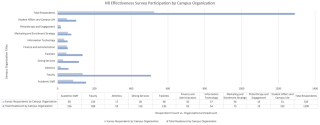Report by Jackson Short, Lead, HR Strategy & HRIS
Human Resources Effectiveness Survey
Survey Documents
Why the HR Effectiveness Survey?
The workplace as we know it – at IC and across the nation – has experienced drastic changes over the last few years. The centering of technology, hybrid/remote work arrangements, and new methods for convening with peers beyond a conference room include some of the changes that were progressed by COVID-19 and have now become our everyday. As such, it is imperative that IC Human Resources transform to accommodate this new means of working and to find ways to best support the College’s Faculty and Staff across new climates and mediums.
The purpose of the HR Effectiveness Survey is to understand the relationship between IC Faculty and Staff and Human Resources, to better understand how we can work to support the needs of our employees and to provide resources that make work more productive while enriching our campus culture. This survey is part of a larger exercise: taking the pulse of our community to better plan out the strategic mission and vision for IC HR service design, offerings and incentives that reflect what our community needs and wants.
All faculty and staff, with the exception of student employees, were invited to complete the HR Effectiveness Survey, between February 2 and February 26, 2023. The survey consisted of 52 questions. This survey precedes in-person campus visits, which HR will conduct throughout 2023, to hear from campus organizations about their relationship with HR.
** Please Note: The HR Effectiveness Survey is a holistic survey of HR service offerings, some of which apply to both staff and faculty, and others which only apply to staff. In instances in which program review is geared toward staff employees only, we use “staff”, and in instances in which programs/services apply to staff and faculty, we use “staff and faculty” or “employees”.
How We Designed the Survey
The HR Effectiveness Survey contains three (3) sections: demographic questions, institutional pulse questions, and HR service questions.
College demographic information (including FLSA status, shift status, work arrangement, seniority, and campus organization) was collected to understand the demographic makeup of survey participants. Comparing survey demographics to workforce headcount enabled HR to analyze generalizations drawn from the sample included herein to the current staff/faculty population.
Institutional pulse questions provided a baseline for understanding how our employees’ relationship with HR service was impacted by their relationship with IC as a whole. These questions, for example, provided context about general employee satisfaction with their job, their compensation, their workplace environment, and their work-life balance. These Likert questions offered context to better understand how questions about specific HR service programs and offerings (such as compensation, payroll, benefits, training and development and recruitment), were informed and impacted by our employees’ relationship with other campus programs and offerings beyond HR.
The matrix for these questions offered five (5) choices for respondents to select: Agree, Somewhat Agree, Neither Agree nor Disagree, Somewhat Disagree, and Disagree. For ease of analysis, the “agree” and “somewhat agree” choices, and the “disagree” and “somewhat disagree” choices have been combined into “agree,” “neither agree nor disagree” and “disagree” for the visualizations within this report. When analyzing survey data, Human Resources has reviewed actual data and trends across the five (5) choices in the survey, as well as the data/trends derived from the aggregate of these combined choices.
Points to Note:
- This report only includes survey responses collected in the HR Effectiveness Survey via Qualtrics and, likewise, excludes any qualitative dialogue garnered from in-person information gathering sessions or email correspondence.
- Categories with less than ten (10) responses were automatically excluded from reporting to protect employee anonymity.
- This survey was collected anonymously. While we can deduce basic information from the demographic sample, survey analysis cannot trace any survey response back to an individual. Future surveys that take employee pulse, or ask employees to be honest about HR service, will be anonymous, unless otherwise noted.
Survey Participation
The total count of survey respondents from February 2nd to February 26th represented 45% of our staff and faculty workforce.
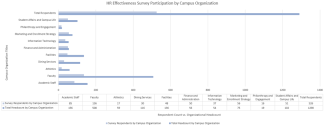
Figure 1. HR Effectiveness Survey Participation by Campus Organization
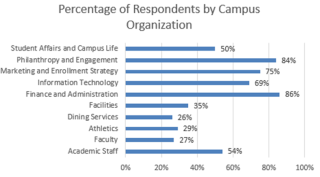
Figure 2. Percentage of Respondents by Campus Organization.
The greatest response count by seniority was employees with 11 to 20 years of experience, with a balance of respondents across all brackets of seniority.
Seniority information provided a helpful context and filter for reading questions about HR service, especially when comparing more recent HR service offerings against employees’ historical experience with previous HR approaches and strategies.
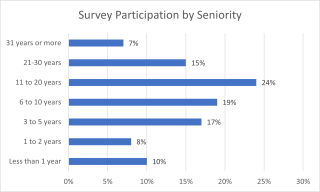
Figure 3. Respondents by Length of Employment with IC.
Seniority information provided a helpful context and filter for reading questions about HR service, especially when comparing more recent HR service offerings against employees’ historical experience with previous HR approaches and strategies.
Compensation Satisfaction
While employee job satisfaction was relatively high, the survey suggests that inflation of job responsibilities has outpaced the College’s compensation increments and market changes. Likewise, recognition for day-to-day work and career advancement opportunities were lower than anticipated. 29% of employees are dissatisfied with the recognition they receive for their day-to-day work and, likewise, 34% believe they do not have opportunities for career advancement at IC.
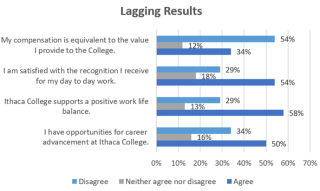
Figure 4. Employee Satisfaction with compensation, recognition, work life balance, and advancement.
While the College’s compensation philosophy is designed to provide employees the opportunity to upskill and progress across job functions (from support, to specialized, to management-level roles), greater focus can be placed on educating employees and managers about the core attributes of the total compensation philosophy to provide clarity and support for employees seeking advancement. And, likewise, review of job descriptions and attributes can help to alleviate the burden that employees may face in efforts toward advancement: increased workload, decreased work-life balance, and gaps in recognition and reward for personal and professional development, and skill attainment.
Human Resources should conduct careful review of market competitiveness, pay equity across the organization, annual progression of our pay bands, and compensation policies to ensure that total compensation competitively grows alongside the market. Human Resources should look to recruiting, onboarding and development strategy to provide clarity to employees and managers regarding internal promotion and transfer, as well as to managerial and leadership development to upskill employees and prepare them to advance within the College.
A Flexible World
Flexible Work Arrangements for staff at Ithaca College increased in response to COVID-19 and have since remained steady. Entire positions have been redefined to accommodate 100% work from home or hybrid work between home and campus across all job levels at the College. 57% of survey respondents agreed that if their job allows, they wish to work remotely in the future. The College’s recruiting function should take the pulse of applicants to determine if the lack of a hybrid/remote option in a vacant role that could accommodate it would be a dealbreaker for candidates.
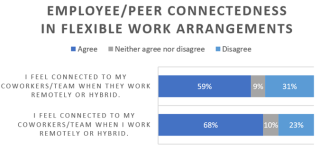
Figure 5. Employee/Peer Connectedness in Flexible Work Arrangements.
Survey results suggest that HR should invest in agile and flexible work environments when appropriate – ensuring that service offerings and the workplace community supports employees in hybrid and remote environments, while also ensuring that employees who predominantly report on campus do not receive the brunt of traditionally “on-campus/in-office” labor if it’s not part of their job description (including, reception work, mail organization, printing/faxing, answering phones, event planning/coordination, etc). With this in mind, there are training/development gaps inherent in the flexible work policy which may offer HR an opportunity to work across campus to better design hybrid-forward work environments, that reimagine traditional modes of working while increasing productivity and equity for all work environments (whether 100% remote, hybrid, or 100% on campus).
As this is the College’s first thorough review of the flexible work policy, it was important for Human Resources to understand how connectedness, belonging and community were fostered in a hybrid/remote environment and if there were learning gaps inherent in the transition to a hybrid-forward environment. 68% of respondents stated that they feel connected to their coworkers/team when working remotely or hybrid. This percentage decreased, however, when their coworkers/team members were working remotely or hybrid (with only 59% feeling connected to their peers that were remote/hybrid).
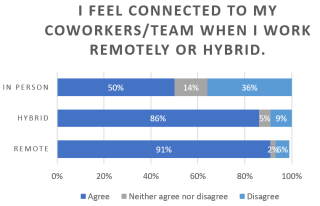
Figure 6. Responses to Employee Connectedness to Teammates When Respondent Works Remotely
Our hypothesis was that remote/hybrid workers would feel less connected to the office than those reporting to campus, because of traditional modes of engagement (around the water cooler, in close proximity like conference rooms and hallways, and going out to lunch). To investigate this notion, we analyzed the respondent sample by work arrangement. Filtered responses suggested the opposite of our hypothesis. To both questions, hybrid and remote workers felt more connected to their coworkers/team than their on-campus peers when working remotely or hybrid. 36% of predominantly on campus workers did not feel connected to their peers when working from home, and 50% of on campus workers did not feel connected to their peers, when their peers worked from home.
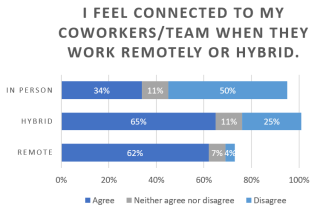
Responses to Employee Connectedness to Teammates When Respondents' Coworkers/Team Work remotely.
HR should develop training offerings that better define “how to hybrid,” to ensure equity, fair division of labor across teams, and to enhance the marketplace for ideas, communication, productivity, and connectivity. This includes defining meeting etiquette for hybrid-first meetings, evaluation of the traditional 9-5 work schedule, and calendar and time management to promote employee wellness and to restrict overwork/burnout.
However, investment in hybrid and remote work options may also require the College to review its traditional means of working in office, to ensure that traditional means of access (such as reception, switchboard monitoring, and in-person meetings) can still positively contribute to the student and employee experience, without inadvertently shifting that labor to employees reporting on campus (especially when that support is not part of their job description).
HR as HR
Because Human Resources functions as the nucleus for employee workplace changes, review, policies, and rewards, it is imperative that HR is as accessible and available to our clients as possible.
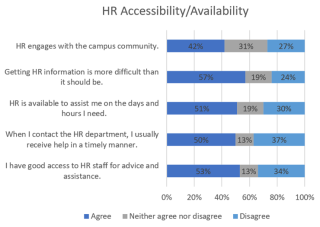
Figure 8. HR Accessibility and Availability
30% of employees surveyed stated that HR is not available to assist them on the days and hours they need, and 37% of employees stated that when contacting HR, service was not delivered in a timely manner. Human Resources should review its issue/request intake procedures and utilize issue tracking technology, as appropriate, to commit to, and to better track, response time and to ensure availability when employees need us.
In doing so, it is incumbent upon HR to define a standard response time based on issue/request severity and to commit to that policy to ensure stability and to strengthen our relationship with our clients. This is also in line with survey trends stating that only 52% of respondents believe HR provides information that is accurate the first time around, 57% believe HR provides helpful and accurate information, and only 50% believe HR exhibits a solid understand of HR issues. It is incumbent upon HR to review HR procedures, responsibilities, and objectives to ensure consensus in employee support and to increase our internal communications and education to ensure that information is as accurate and clear as possible the first time our clients request it.
It is also important to note that there are three (3) standard shift schedules at the College: day shift, evening shift and night shift. Currently, HR staff are day shift employees only. Reviewing responses to the statement “HR is available to assist me on the days and hours I need” based on the shift schedule of the respondents provides important context to the shift groups who feel best supported by HR’s service hours. In reviewing how HR ensures service availability and accessibility, it will be important to consider how shift schedules may introduce roadblocks for employees who need to access HR services, as employees predominantly working the evening and night shift may be prevented from reaching HR for questions/solution, or attending HR presentations, events, or meetings.
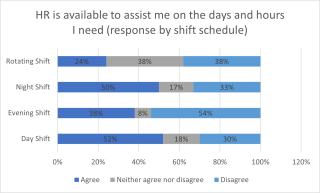
Figure 9. Satisfaction with HR Availability by Respondent Shift Schedule
It is also important to note that there are three (3) standard shift schedules at the College: day shift, evening shift and night shift. Currently, HR staff are day shift employees only. Reviewing responses to the statement “HR is available to assist me on the days and hours I need” based on the shift schedule of the respondents provides important context to the shift groups who feel best supported by HR’s service hours. In reviewing how HR ensures service availability and accessibility, it will be important to consider how shift schedules may introduce roadblocks for employees who need to access HR services, as employees predominantly working the evening and night shift may be prevented from reaching HR for questions/solution, or attending HR presentations, events, or meetings.
HR Communication Practices
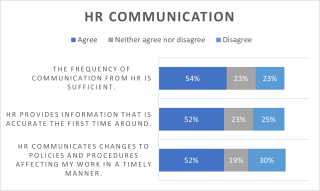
Figure 10. Satisfaction with HR Communication
Part of reviewing quality of HR service means reflecting on the ways in which we work within Human Resources and the role that we play in pursuit of the College’s strategic goal of becoming an employer of choice. This means reviewing historical and more nascent programs in HR – such as the HR Business Partner model, the transition toward HR Cloud based self-service, analytics, and data processing, and HR’s relationship with College divisions—to understand what progresses us and what presents roadblocks toward realizing our mission.
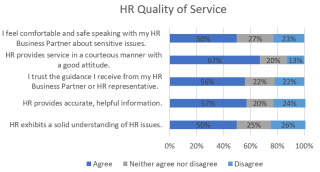
Figure 11. HR Quality of Service
67% of respondents agree that HR service is delivered in a courteous manner with a good attitude. However, 23% of respondents do not feel comfortable and safe speaking with HR Business partners about sensitive issues, and 22% do not trust the guidance they receive from their HR Business Partner.
In order for HR to focus on identified gaps in service and to meet expectations of the campus community and strategic goals, review of the HR Business Partner staffing and resource model as well as overall HR centers of excellence is critical in order to increase trust between the HR team and staff and faculty of the College. Additionally, HR should develop an ongoing, anonymous feedback survey to ask more specific questions about how HR’s structure, service quality and communication methods affect our clients trust in our service and to ensure that our design creates a safe space for our clients to speak openly about sensitive issues.
Recruitment and Onboarding
Resource availability and increased job responsibilities for ICHR team members has constrained support for recruiting and onboarding efforts. It is important to note that several internal HR departments were eliminated in the creation of the HR Business Partner model, including Total Rewards and Workforce Strategy (Compensation & Classification), Engagement and Talent Management (Recruiting, Engagement, Employment), and Training and Development. In realizing the HR Business Partner model, the strategic and operational priorities for these centers of excellence have been placed on HRBPs. While operational recruiting processes have performed successfully, there has been limited time to focus on recruiting events, marketing and campaigns, sourcing, pilot programs, incentives, and training and education.
A decline in staffing and resources to solely support recruiting, sourcing and strategy has introduced confusion regarding the relationship between hiring departments, hiring managers, and HR recruiters, leading to uncertainty about the role employees play in the recruitment and onboarding of staff and faculty at IC.
54% of respondents agreed that they would encourage prospective employees to work at IC – this aligns with the positive trend (72%) of employees who are satisfied with their job at IC. However, when it comes to education around the College’s recruiting philosophy, recruiting process, and shared roles, only 26% of respondents have an understanding of their role in the recruitment and onboarding experience of new hires within their campus organization, and search committee training has decreased since the College’s transition to remote operating status at the onset of COVID-19.
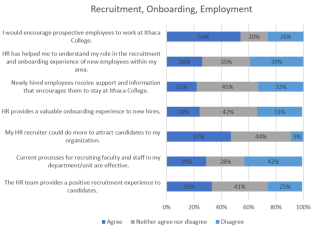
Figure 12. Satisfaction with Recruiting, Onboarding and Employment
This translates into the notion shared by 33% of respondents who believe that newly hired employees do not receive support and information that helps them stay at the College. Likewise, 47% of respondents believe that their HR Recruiter could do more to attract/retain talent for their area. It is evident from this data that an audit of the recruitment and onboarding program is necessary and that gaps exist in the sourcing, recruitment, and onboarding of candidates.
This aligns, importantly, with current people analytics suggesting that a new hire’s first forty-five (45) days are critical in determining the viability of employee retention within the organization (Harvard Business Review). As HR reviews/manages turnover, in collaboration with IC leadership, it will be imperative that HR upskill the College in effective practices for onboarding and orienting employees within their organization, their position, and their team. In doing so:
- HR should clearly define the roles that campus departments and HR share in the partnership to recruit and onboard talent (and to identify existing talent within the internal candidate marketplace to provide progression, retention, and upskilling opportunities for our existing workforce).
- HR should audit current practices and campaigns aimed at recruiting and sourcing talent to ensure its effectiveness – defining the candidate value proposition to increase candidate pools and to reduce time-to-hire statistics.
- HR should continue its efforts to expand onboarding opportunities across a variety of mediums (web-based, in person, hybrid) and across various employee milestones (first day, first 6 months, first year, first promotion, etc) to ensure employees can stay engaged with IC and also receive information that supports them in each of their positions at the College. (At the time of this survey, the only onboarding offering was a module offered through IC HR Cloud. Beginning March 2023, an in-person onboarding offering was re-introduced for new hires.)
Training and Development
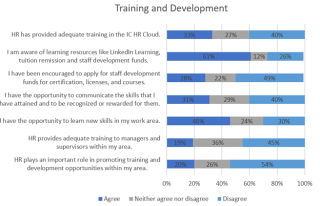
Figure 13. Satisfaction with Training and Development
Training and development programs at the College support all stages of the employee lifecycle: ensuring new hires have the resources to succeed at their job; ensuring employees receive opportunities for career development, progression, and skill attainment; and ensuring that change strategies are understood and accepted when College processes and technologies change. Only 20% of respondents believe HR plays an important role in promoting training and development opportunities, and 19% of respondents believe HR provides adequate training to managers and supervisors.
While training and development should occur at all levels of the institution: from College programs, from HR, from departments/teams, an accepted philosophy for staff training and development can offer clarity to College employees about their role in crafting and participating in development plans for themselves, their peers, and their teams, and in taking advantage of available resources and programs.
HR Should place a larger focus on training and development – specifically, highlighting the range of development offerings offered by IC, and helping to connect development with employee rewards, recognition, and job progression. In doing so:
- HR should ensure that information about career development and training extends beyond the onboarding period and supports employees across all job levels and periods of service.
- HR should provide management/leadership training to managers of staff and student employees to ensure that managers are prepared to meet today’s workplace challenges and to better equip managers to respond to employees’ needs.
- HR should promote existing development opportunities (staff development funds, LinkedIn Learning), while providing new professional curricula and development opportunities across a range of different formats: team development seminars, job level-specific trainings, web-based training curricula, and self-paced learning offerings.
- HR should partner with Finance and IT to ensure that education on technology, including the IC HR Cloud is consistent, straight-forward, and available to new and seasoned employees.
Total Rewards Administration: Payroll, Benefits, Compensation
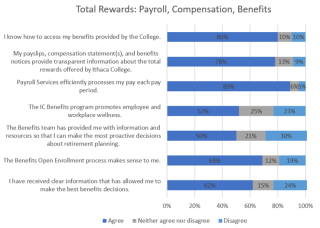
Figure 14. Satisfaction with Total Rewards Programs & Administration
The Payroll and Benefits service areas within the Office of Human Resources administer and deliver the College’s Total Rewards programs to employees. Responses regarding payroll efficiency, benefits access and the Open Enrollment process were positive, with 80% of employees agreeing that they know how to access their benefits, 78% believing that statements and notices are transparent, and 89% agreeing that payroll efficiently delivers employees’ pay each pay period.
There was greater neutrality and disagreement regarding the promotion of workplace wellness and retirement planning. 23% of respondents do not agree that the benefits program promotes employee and workplace wellness and 30% believe they have not been provided with the information necessary to make proactive decisions about retirement planning. Greater promotion of employee financial wellness services, like WellCents, as well as increased education regarding Benefits’ vendor partnerships with TIAA, Aetna, PayFlex and NFP may help to direct employees toward financial, medical/retirement benefit, and investment advisement that can help them make the most of their College benefits and plan for their futures.
Pulse surveys should be taken after Annual Compensation Increment and Open Enrollment to identify specific areas of growth and review that may be present in the College’s Total Rewards delivery.
The HR Effectiveness Survey, and corresponding analysis, was the first step in identifying opportunities to implement controls and to transform HR service. The conversation continues with campus visits throughout the Summer and conversation with internal HR working groups.
The strategic goals and vision for HR Transformation will be communicated to campus in Fall 2023.
We are excited to engage with you as we realize the future of ICHR. For more information about our transformation timeline, plans, and next steps, please visit our website, or email Jackson Short, Lead, HR Strategy & HRIS at jshort1@ithaca.edu

